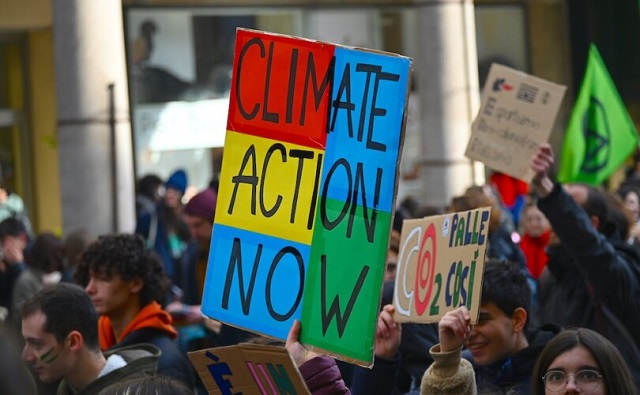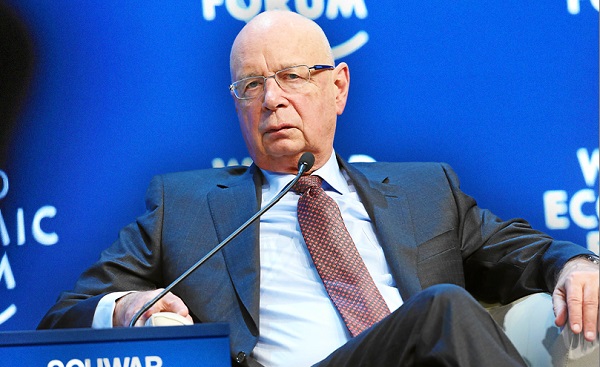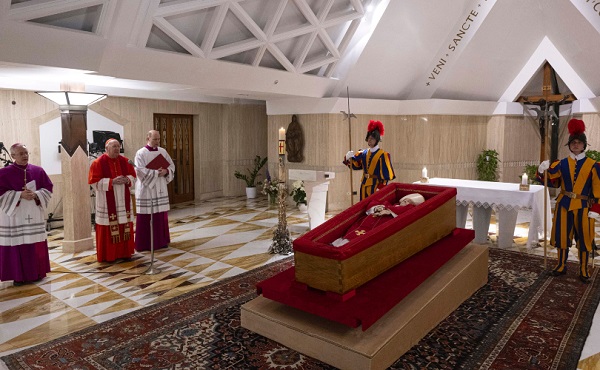Economy
The Green Army Will Keep Pushing Unrealistic Energy Transition in 2025 Despite “Reality”

From EnergyNow.ca
By Irina Slav
The facts behind energy transition are so staggeringly counter to common sense that the only way to achieve them is by force, and the only path ahead is failure.
I was going to wrap this eventful year with a nice little post of gratitude but, as usual, the news flow has forced me to revise my plans. So much has happened in the last week days failing to report on it would be a real shame. You may want to put down the hot beverage or, then again, not put it down, you’re the master of you.
A few years ago, during some election campaign or other — we’ve had so many it’s hard to keep track — one of the most popular parties in Bulgaria chose as its slogan “Work, work, work!” Naturally, the slogan became the butt of many jokes almost immediately.
More recently, we were graced with the “Fight! Fight! Fight!” adage from the Trump campaign that was nowhere near as amusing. It also worked. Meanwhile, the transition army is moving fast towards a “Force! Force! Force!” stage in its efforts to keep the green ball rolling.
Consider the latest gem from the International Energy Agency, out this week. The press release for the report was headlined Global coal demand is set to plateau through 2027, with the subheader summary stating that “New IEA report finds that strong deployment of renewables is set to curb growth in coal use even as electricity demand surges, with China – the world’s biggest coal consumer – remaining pivotal.”
What the report actually admitted, however, was that coal supply and demand hit an all-time high this year, they are both likely to scale new highs next year and keep going in that direction until at least 2027. The way things are going with the transition, coal will probably continue growing beyond 2027 as well because much as Fatih and the Transitionettes want it to die, they can’t tell China and India what to do — or anyone else, really, when push comes to shove.
Push appears to have come to shove in Canada already, with the federal government suddenly deciding to walk back its plan for a net-zero grid by 2035. Now, it will be aiming for a net-zero grid by 2050, which is what is going to be happening elsewhere as well —except perhaps in the UK, where everyone’s gone truly insane but more on that later.
So, Canada last week released something called Clean Electricity Regulations that originally, I gather, were supposed to outline plans to remove hydrocarbons from its already pretty green grid by 2035. The provinces, however, objected. And they must have objected strongly enough for an ounce of sanity to crawl into the regulations. Resource minister Jonathan Wilkinson of “We are not interested in investing in LNG facilities” fame called it “flexibility”. Whatever works to make one feel good, I guess.
Here’s a fun fact: the new Clean Electricity Regulations with the revised target come out literally days after the Trudeau government pumped up its emission cut plan, aiming for cuts of 45-50% from 2005 by 2035. All it took was six days and the start of what might end up being complete government meltdown to reconsider that deadline and delay it by 15 years. But stranger things have happened and some are happening right now, one of them at the U.S. Department of Energy.
The regulator of the department, Inspector General Teri Donaldson said in an interim report that the loan office of the DoE should stop giving out loans to green project developers on suspicion of conflicts of interest, or, as Reuters put it, “contractors who vet them may be serving both the agency and potential borrowers.”
From Donaldson’s report: “The projects funded with this authority, which involve innovations in clean energy, advanced transportation, and tribal energy are inherently risky in part because these projects may have struggled to secure funding from traditional sources such as commercial banks and private equity investors.”
Yet these same projects got DoE funding, which naturally raises the question of whether this funding success was at least in part related to the department’s failure to ensure everyone involved in the process was impartial and driven exclusively by professional motives, and I cannot believe I managed to put this stinky situation so delicately.
Anyway, the DoE has struck back immediately, saying the report was full of errors, and accusing Donaldson of “fundamentally misunderstanding” the “implementation of contracting in the Loan Programs Office.” Yeah, that must be it. That’s why she was appointed Inspector General of the department — but by the Trump administration so it doesn’t count.
All of this, however, is pretty weak beer compared to what’s been happening in Europe. VW is not yet bankrupt and the lights are still on in Germany, for the time being, but in the UK, the government has apparently found a way to grow money on trees because the grid operators of the three constituent parts of the UK’s bigger island are planning to spend 77.4 billion pounds on grid upgrades with a view to accommodating more wind and solar into said grid.
The upgrade is a must if Labour’s 2030 decarbonization plan is to have a fighting chance even though the outcome of that fight is already clear and it rhymes with beet, feet, and meat. The money is to be spent between 2026 and 2031, which means that the money trees take two years to start bearing fruit.
Yet here is my concern: with every other form of plant life susceptible to the devastatingly catastrophic effects of climate change, who is to guarantee that the money trees will be spared the devastating catastrophe? No one, that’s who. The UK may fail to accomplish its task of decarbonizing the country’s grid because of the very climate change it wants to neutralize with that decarbonization, and how cruel of an irony is that? Very, is the answer.
Usually, the UK government is difficult to rival in insanity and anti-intelligence but this week we have a serious contender and it’s not Germany’s government. It’s Big Oil and the heavy industry. That’s right. Europe’s energy and heavy industries have been driven to insanity by the climate crusade army although I’d stop short of painting them as innocent victims.
They could have said something. They should’ve said something. And they should’ve said it loud and clear. But they didn’t, so now Big Oil and Big Heavy Industry are asking the EU to force — that’s right, force — consumers to buy their transition cost-loaded products. Because there is no other way of selling those products.
““We will need to focus on demand creation to achieve new investment prospects,” executives from the two sectors said in a letter to Wopke Hoekstra, EU climate commissioner, warning of an “industrial exodus” without intervention,” the FT reported this week.
It also reported that “companies trying to invest in production methods that may result in lower carbon emissions are “pricing themselves out of the market” due to high costs, and authorities need to step in to create demand for their products.” I think this is beautiful, in the same way that an orca catching its pray is beautiful, that is, in a rather terminal way.
I don’t normally like to brag about being right about things, not least because it’s invariably bad things I’m right about, so it is with a sigh of frustration and some boredom that I have to note I have been saying this for two years now — and of course I haven’t been the only one, far from it. The only way for the energy transition to work is through force, and a lot of it. The only way for the transition to work is to eliminate all alternatives to the Chosen Tech, and for some reason Big Oil and the heavy industry seem to believe this is a constructive approach to life, the universe and everything.
What I find most interesting in this situation is the fact that it is extremely easy to find evidence the forceful approach tends to result in outcomes that are the exact opposite of the intended ones. History is full of such evidence. Yet it appears the most essential industries for modern civilization have taken the green “It will work this time” pill and are eagerly digesting it. Which means two things we already knew: one, the transition is doomed as it has been from the start; and two, Europe’s going down unless it uses a fast-closing window to come to its senses. We all know it won’t — unless it’s forced to. Work, work, work, force, force, force, fight, fight, fight.
Business
Trump: China’s tariffs to “come down substantially” after negotiations with Xi

 MxM News
MxM News
Quick Hit:
President Trump said the 145% tariff rate on Chinese imports will drop significantly once a deal is struck with Chinese President Xi Jinping, expressing confidence that a new agreement is on the horizon.
Key Details:
- Trump said the current 145% tariff rate on China “won’t be anywhere near that high” after negotiations.
- He pointed to his relationship with Xi Jinping as a reason for optimism.
- The White House said it is preparing the groundwork for a deal, and Treasury officials expect a “de-escalation” of the trade war.
Diving Deeper:
President Donald Trump on Tuesday told reporters that the steep tariff rate currently imposed on Chinese imports will come down substantially after his administration finalizes a new trade deal with Chinese President Xi Jinping. While the current level stands at 145%, Trump made clear that number was temporary and would be adjusted following talks with Beijing.
“145 percent is very high. It won’t be that high, it’s not going to be that high … it won’t be anywhere near that high,” Trump said from the Oval Office, signaling a shift once a bilateral agreement is reached. “It will come down substantially, but it won’t be zero.”
The tariff, which Trump previously described as “reciprocal,” was maintained on China even after he delayed similar penalties on other trading partners. Those were cut to 10% and paused for 90 days to allow room for further negotiation.
“We’re going to be very nice. They’re going to be very nice, and we’ll see what happens. But ultimately, they have to make a deal because otherwise they’re not going to be able to deal in the United States,” Trump said, reinforcing his view that the U.S. holds the leverage.
Trump’s remarks come as markets remain wary of ongoing trade tensions, though the White House signaled progress, saying it is “setting the stage for a deal with China.” The president cited his personal rapport with Xi Jinping as a key factor in his confidence that an agreement can be reached.
“China was taking us for a ride, and it’s not going to happen,” Trump said. “They would make billions a year off us and build up their military with our money. That’s over. But we’ll still be good to China, and I think we’ll work together.”
Treasury Secretary Scott Bessent also said Tuesday that he expects a cooling of trade hostilities between the two nations, according to several reports from a private meeting with investors.
As the 90-day pause on other reciprocal tariffs nears its end, Trump emphasized that his team is prepared to finalize deals quickly. “We’ve been in talks with many, many world leaders,” he said, expressing confidence that talks will “go pretty quickly.”
White House Press Secretary Karoline Leavitt added that the administration has received 18 formal proposals from other countries engaged in trade negotiations, another sign that momentum is building behind Trump’s broader push to restructure global trade in favor of American workers and businesses.
(Li Xueren/Xinhua via AP)
2025 Federal Election
Next federal government should end corporate welfare for forced EV transition

From the Fraser Institute
By Tegan Hill and Jake Fuss
Corporate welfare simply shifts jobs and investment away from other firms and industries—which are more productive, as they don’t require government funding to be economically viable—to the governments’ preferred industries and firms, circumventing the preferences of consumers and investors. And since politicians spend other people’s money, they have little incentive to be careful investors.
General Motors recently announced the temporary closure of its electric vehicle (EV) manufacturing plant in Ontario, laying off 500 people because its new EV isn’t selling. The plant will shut down for six months despite hundreds of millions in government subsides financed by taxpayers. This is just one more example of corporate welfare—when governments subsidize favoured industries and companies—and it’s time for the provinces and the next federal government to eliminate it.
Between the federal government and Ontario government, GM received about $500 million to help fund its EV transition. But this is just one example of corporate welfare in the auto sector. Stellantis and Volkswagen will receive about $28 billion in government subsidies while Honda is promised $5 billion.
More broadly, from 2007 to 2019, the last pre-COVID year of data, the federal government spent an estimated $84.6 billion (adjusted for inflation) on corporate welfare while provincial and local governments spent another $302.9 billion. And crucially, these numbers exclude other forms of government support such as loan guarantees, direct investments and regulatory privileges, so the actual cost of corporate welfare during this period was much higher.
Of course, politicians claim that corporate welfare benefits workers. Yet according to a significant body of research, corporate welfare fails to generate widespread economic benefit. Think of it this way—if the businesses that received subsidies were viable to begin with, they wouldn’t need government support. So unprofitable companies are kept in business through governments’ support, which can prevent resources, including investment and workers, from moving to profitable companies, hurting overall economic growth.
Put differently, rather than fuelling economic growth, corporate welfare simply shifts jobs and investment away from other firms and industries—which are more productive, as they don’t require government funding to be economically viable—to the governments’ preferred industries and firms, circumventing the preferences of consumers and investors. And since politicians spend other people’s money, they have little incentive to be careful investors.
Governments also must impose higher tax rates on everyone else to pay for corporate welfare. In turn, higher tax rates discourage entrepreneurship and business investment—again, which fuels economic growth. And the higher the tax rates, the more economic activity they discourage.
GM’s EV plant shut down once again proves that when governments try to engineer the economy with corporate welfare, workers will ultimately lose. It’s time for the provinces and the next federal government—whoever it may be—to finally put an end to this costly and ineffective policy approach.
-

 2025 Federal Election2 days ago
2025 Federal Election2 days agoBREAKING: THE FEDERAL BRIEF THAT SHOULD SINK CARNEY
-

 John Stossel2 days ago
John Stossel2 days agoClimate Change Myths Part 2: Wildfires, Drought, Rising Sea Level, and Coral Reefs
-

 2025 Federal Election2 days ago
2025 Federal Election2 days agoCHINESE ELECTION THREAT WARNING: Conservative Candidate Joe Tay Paused Public Campaign
-

 Media2 days ago
Media2 days agoCBC retracts false claims about residential schools after accusing Rebel News of ‘misinformation’
-

 Business2 days ago
Business2 days ago‘Great Reset’ champion Klaus Schwab resigns from WEF
-

 Bjorn Lomborg2 days ago
Bjorn Lomborg2 days agoNet zero’s cost-benefit ratio is CRAZY high
-

 International2 days ago
International2 days agoPope Francis’ funeral to take place Saturday
-

 Business17 hours ago
Business17 hours agoTrump: China’s tariffs to “come down substantially” after negotiations with Xi







